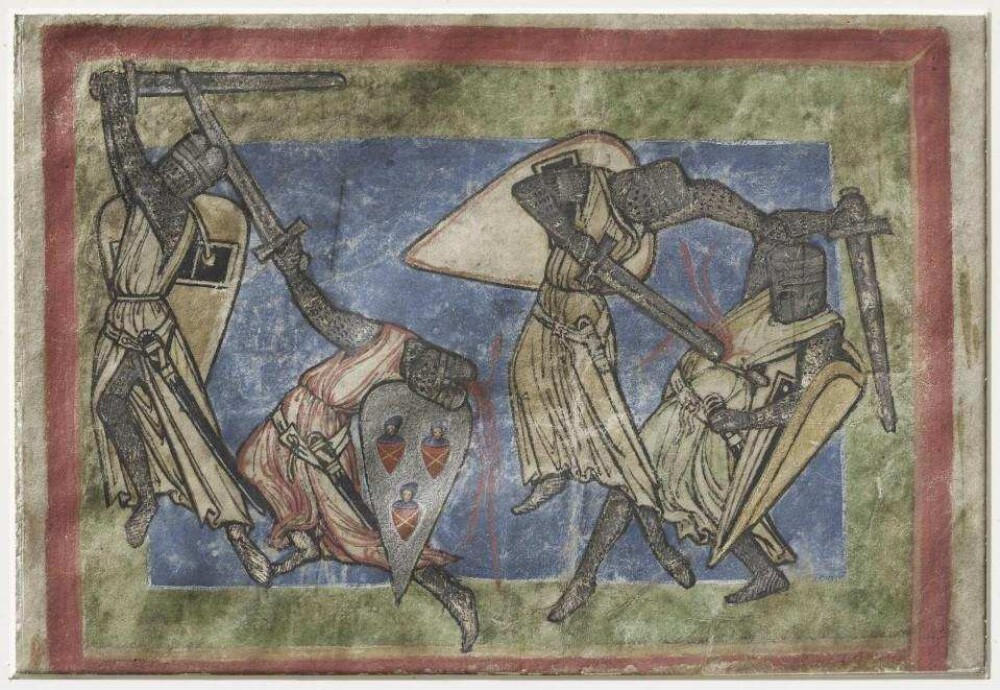Speculum virginum. Fragment
Pergament - 1 BI - 13,5 x 19,6cm - Mittelrhein – Ende 12. Jh
Pergamentfragment. vertikale Bruchfalte. Ursprüngliches Recto und Verso nicht mehr feststellbar. Im folgenden Buchmalerei = Verso, Text auf der Rückseite = Recto.
Recto: Schriftraum: 12,5 x 16 cm, zweispaltig, 17 Zeilen. Carolino-Gothica. Dreizeilige Lombarde mit Blattmuster im Binnengrund.
Verso: oberer Teil einer ursprünglich zweizonig angelegten MINIATUR. 12,5 x 17,8 cm. von grosser künstlerischer Vollendung (Tafel XIX).
Auf blauem, grün umrandetem Grund zwei Paar kämpfender Ritter. Angetan mit Ringelpanzer und Beinlingen aus Panzergeflecht, darüher textile, ärmellose Waffenröeke.
Topfhelme mit Sehschlitz und Luftlöchern und umgehängten, oben abgerundeten normannisehen Dreiecksschilden
(Vgl. Ortwin Gamber, Die Bewaffnung der Stauferzeit, in: KAT. STUTTGART, Bd. 3, S.113—118).
Krafrvolle Bewegungen von großer Eindringlichkeit und Unmittelbarkeit.
Der linke Ritter schwingt sein Schwert über dem Kopf, während sein zusammensinkender Gegner seinen Helm spaltet.
Das Schild des letzteren mit Wappen, darauf brevierte Mönchsdarstellungen.
Bei dem rechten Paar packt der linke Ritter seinen Gegner am Arm und stößt ihm sein Schwert in die Brust, während der rechte sich nach rückwärts neigt und zum Schlage aushult.
Schwarze und rote Federzeichnung, leicht grün und braun laviert. Die Rütungen in Silber, die Schilde golden oder silbern.
Kein zeitgenössischer Kampf, sondern allegorische Darstellung des Kampfes zweier Tugenden mit den niedergeworfenen Lastern.
Die Illustration gehört zum 4. Buch des Jungfrauenspiegels über den Stolz, das in der Regel nur mit einer Miniatur „Der Sieg der Demut über den Stolz“ ausgestattet ist.
Letztere bildete wohl den Inhalt des verlorenen unteren Teils der zweizonigen Miniatur.
Source: Handschriften des Kestner-Museums zu Hannover von Helmar Härtel
|
Speculum virginum. fragment
Parchment - 1 BI - 13.5 x 19.6cm - Middle Rhine - end of the 12th century
Parchment fragment. vertical fold. Original recto and verso no longer detectable. In the following book illumination = verso, text on the back = recto.
Recto: Lettering space: 12.5 x 16 cm, two columns, 17 lines. Carolino-Gothica. Three-line Lombard with leaf pattern in the inner ground.
Verso: upper part of an originally two-zone MINIATURE. 12.5 x 17.8 cm. of great artistic perfection (panel XIX). Two pairs of knights fighting on a blue background with a green border. Dressed in maille and chauses made of armoured mesh, on top of which a textile, sleeveless tunic.
Pot helmets with a viewing slit and air holes and slung Norman triangular shields rounded at the top
(cf. Ortwin Gamber, The armament of the Staufer period, in: Cat. STUTTGART, Vol. 3, 113-118).
Powerful movements of great urgency and immediacy.
The left knight swings his sword over his head while his collapsing opponent splits his helmet.
The shield of the latter with a coat of arms, upon it representations of monks’ heads [a later addition?].
In the pair on the right, the knight on the left grabs his opponent by the arm and thrusts his sword into his chest, while the one on the right bends backwards and hurls out to strike.
Black and red pen drawing, light green and brown wash. The guards in silver, the shields gold or silver.
Not a contemporary struggle, but an allegorical representation of the struggle between two virtues and the vices that have been thrown down.
The illustration belongs to the 4th book of the Jungfrauenspiegel 'On Pride', which is usually only provided with one miniature “The victory of humility over pride”.
The latter probably formed the content of the missing lower part of the two-zone miniature.
|

